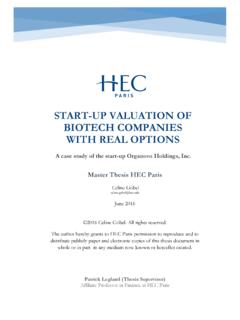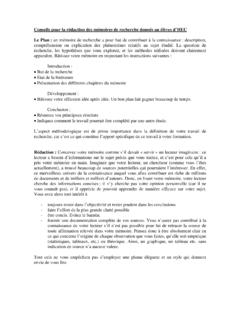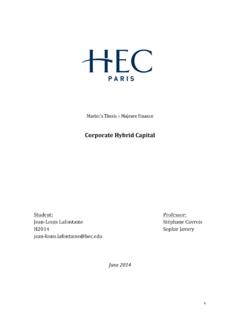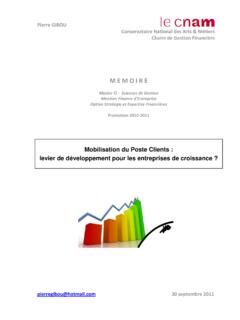Transcription of How to value a start-up? - Vernimmen.net
1 HEC PARIS How to value a start -up? The use of options to assess the value of equity in start -ups Guillaume Desach 2 Executive summary The question of start -up value is mostly interesting for two kinds of people: the entrepreneur, for whom it is a form of rewarding his work, and the outside investor, either as an individual or as a corporation for whom a fair value is necessary to profit from an investment in the firm. The well-established techniques such as the DCF approach or the multiples valuation that exist for valuing mature companies are irrelevant to value start -ups. Why? Because contrary to mature profit-making firms, where activity can be reasonably forecasted from past results, this is impossible for new firms, where the actual market for a new product is completely unknown. They are also irrelevant to deal with the very binary kind of payoffs of an investment in a start -up: success or failure.
2 To truly assess those risks, but also the potential of value creation imbedded in start -ups, we need to recourse to more innovative methods, such as the real option method, which takes into account the potential of the firm to change its strategy through time and adapt to new market circumstances. However, this complex method is not often used in practice, and is replaced by the venture capital method, which has flaws and has less theoretical justifications. The problem is therefore to build a valuation technique that enables at the same time to understand the dynamics of the business, as the DCF approach enables to do, and to capture the risk profile of a start -up company, making it closer to the real option framework. This is what I have tried to do in the last part of this research paper. But as start -up valuation mostly occurs in the framework of a capital increase, we will see that valuing a start -up cannot be limited to valuing the standalone value of the firm.
3 Adjustments have to be made concerning the cost of capital and the shareholding structure, and here again, reasoning in terms of options gives precious insight. 3 Summary Executive summary .. 2 Introduction .. 5 I) The limitations of the traditional valuation approaches in valuing a start -up .. 8 1) The DCF approach .. 8 a) Justification and principles .. 8 b) Limits in the case of start -ups .. 10 c) Possible adjustments to the case of start -ups .. 12 2) The multiple approach .. 16 a) Principles of the method .. 16 b) Limitations .. 17 II) Real option valuation as well as venture capitalist methods give a better view of a start -up value .. 19 1) Real options capture two essential dimensions of a start -up: time and adaptability .. 19 a) The creation of a start -up is an adaptive and step-by-step process .. 19 b) Principles of the real option method .. 22 c) Valuation of real options and application to the start -up case.
4 23 d) limitations .. 30 e) Adjustments .. 31 2) Broadly used in practice, the Venture Capital Method is pragmatic but has its flaws .. 33 a) Principles of the method .. 33 b) Limits of the approach .. 35 3) The first Chicago Method, a good compromise between the two previous ones? .. 38 III) Proposition of a new valuation method .. 38 1) Proposition of a new valuation method .. 39 a) Standing point and objectives of the method .. 39 b) Presentation of the method .. 39 c) example .. 41 d) Comments .. 44 2) Special features of a start -up shareholder s agreement have to be taken into account into the post-money valuation .. 44 a) The heterogeneity of the cost of 44 b) How to value contractual clauses in the shareholder agreement? .. 47 Conclusion .. 50 Bibliography: .. 51 4 5 Introduction On the 7th of November 2013, Twitter was IPOed at a price of $26 per share, thus valuing it at $ billion, namely 20 times its current turnover.
5 By many standards in valuation, such a price can be considered as extremely high. But most surprisingly, on the first day of trading, the stock price increased by a staggering 73% to $45, implying a valuation of $30 billion, around 60 times Twitter s current turnover. And the price has hitherto remained at high valuation levels, around $45-$50. However, when one looks at Twitter s financials, one realizes that the company is far from profitable yet, still incurring a $130 million loss for fiscal year 2013, and even the management does not believe it will be before 2015 at the very least. What would make Twitter so special that investors would be willing to buy a share of its equity for 60 years of the company s turnover given those assumptions? The answer is simple: growth. Indeed, just before it was introduced, Twitter revealed a 100% growth rate of its turnover in one quarter only.
6 At such a pace, only three years and a half are needed to multiply the turnover by more than 100. In a business where most costs are fixed, one can easily understand how profitable such a business can become. But growth sustainability is a big if for such a company which suffers from a decline in the price of its advertisement sales, and a higher competition from other technological firms whose revenues also stem from ads: Facebook, Twitter s potential to reach profitability is therefore far from certain. It is not given that Twitter has already found the right business model to stay on business for a long time. Twitter epitomizes many of the problems that arise in valuing a new business: high growth potential, very limited financial history, many financial indicators such as EBITDA or Net income are negative or very small, risk of failure is high.
7 All those factors make it very difficult to apply traditional valuation techniques in order to estimate the enterprise value . Indeed, the discounted cash flow method (DCF) consists in measuring all the cash flows produced by the firm during all its lifetime and discount them at a rate that takes into 6 account the risk inherent to the activity of the firm. Generally, three periods of time are considered: an explicit horizon during which cash flows can be forecasted quite accurately, a soft landing , which correspond to the period when the firm gradually reaches maturity, and the terminal horizon, during which cash flows are assumed to grow at a constant low rate. The matter with this method is that for a firm that has just been created or with low track record, it is extremely hard to know how long it will take the firm to reach maturity, to know how much of its potential market it will capture, or more pragmatically, it is hard to know if the firm will survive at all.
8 In 100 new ventures, only 16% survive the first ten years1. Therefore, it is extremely hard to build a reliable business plan. Then, even if you suppose you are actually able to build a realistic business plan, how can you find the right discount rate? Indeed, the discount rate is usually computed on mature listed companies which bear less risk than a new venture that will most probably fail even before breaking even. The other classical method consists in looking at other listed companies that are comparable (in terms of sector of activity, margins, growth ) and compare their value to their key financials: Turnover, EBITDA, EBIT, Net Those multiples, applied to the company to be valued then easily yield the enterprise value or the equity value . But how to find a pertinent comparable when you try to evaluate a start -up, which is by definition an innovative company?
9 Now, why do we care about valuing start -ups? Or rather, who cares about start -ups value ? As explained above, one of the main features of start -ups is the uncertainty of the cash flows that are related to their activity. This makes debt financing extremely hard for them, for debt requires a steady stream of cash flows in order to be reimbursed. Besides, especially in activities with little asset base, bankers will be extremely cautious to lend because there will be no possibility to pledge some assets as a guarantee2. 1 Vernimen, Finance d entreprise by Pascal Quiry and Yann Le Fur, 2014 edition p902. Based on a study between 2003 and 2013. 2 In practice, the entrepreneur can borrow money by pledging some of his own assets (house, ) but then this debt is not part of the firm s debt. 7 This impossibility, or at least weak probability to be able to finance by debt makes equity financing an almost unavoidable fact.
10 And that s where the importance of the firm value comes into play. The first people to take part in the equity financing of the firm is the entrepreneur, or a group of entrepreneurs, pooling together their resources to finance their new venture. At this stage, what matters is that everyone gets a share of equity that corresponds to the value he will bring to the future company. As those resources are generally not sufficient to start a proper business, they also address their fools, friends and family to get a little extra help against a symbolic share of equity. This money being invested not for financial reasons but mostly for the personal attachment to the people creating the company, it has been nicknamed Love Money . However, at one point or another, depending on the nature of the business, the firm will have to look for outside investors, who will intervene at different steps of the company life: business angels, venture capitalists and private equity funds.














